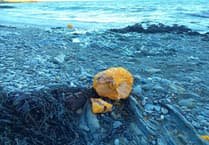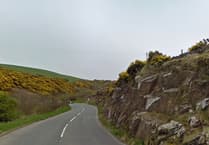Medieval stone crosses have had new visitor information plaques installed.
Manx National Heritage (MNH) and the Diocese of Sodor and Man have put in the information plaques to St Adamnan’s, otherwise known as Lonan Old Church, next to each of its crosses.
Andrew Johnson, inspector of ancient monuments for MNH, said: ’The Manx crosses are works of art, written documents and religious artefacts, and have an extraordinary capacity to tell us about our ancestors, the people who created them.
’The presence of these memorials is one of the reasons why this was chosen as the centre of the parish almost nine centuries ago.’
The church stands on the site of an earlier chapel to which it’s still partially connected by old paths leading to the coast at Baldrine and Groudle.
It’s home to eight medieval carved crosses, dating from the seventh to tenth centuries.
Reverend Jo Dudley, vicar of St Adamnan’s Church, said: ’We are grateful that working together we can display information to visitors about the significance of these old crosses.
’I hope it will encourage folk to enter the sacred building where they too can experience the peace of the place.
’The area surrounding the church is one of the most beautiful that I have ever seen.
’I hope that all who visit enjoy the surroundings of St Adamnan’s and take away a greater understanding of our spectacular medieval crosses.’
According to MNH, the Isle of Man has one of the ’most significant’ collections of carved medieval stone memorials found anywhere in the British islands.
There are more than two hundred carved crosses in the island, which range from simple grave-markers to intricately decorated memorials.
Reverend Dudley added: ’To gaze on the handiwork of the crosses and to see that they and the faith have stood the test of time is so affirming and reassuring in these unprecedented times.’
On June 16, 1968, a meeting was held to form the Friends of St Adamnan’s.
’They now, as then, support the vicar and wardens in caring for the building with membership drawn from across the world,’ she said.
The crosses were created during a pivotal period of the island’s history, from its conversion to Christianity 1500 years ago, through the arrival of Norse settlers in the 10th century, and culminating in the reorganisation of the church along European lines in the 12th and 13th centuries.
Many crosses depict figures of people, pagan gods, animals and mythical monsters, which tell stories, support religious beliefs and express the identity of Manx people.
Around a fifth of the island’s crosses bear inscriptions and are the only documents from this period.
For anyone unable to visit, each of the island’s crosses has been laser scanned and is available to view online on iMuseum.
Further information on the cross collection was recently published in Manx Crosses: A Handbook of Stone and Sculpture by David Wilson.


.jpeg?width=209&height=140&crop=209:145,smart&quality=75)


Comments
This article has no comments yet. Be the first to leave a comment.